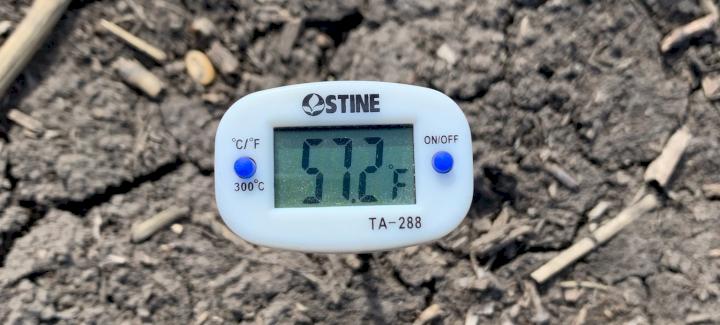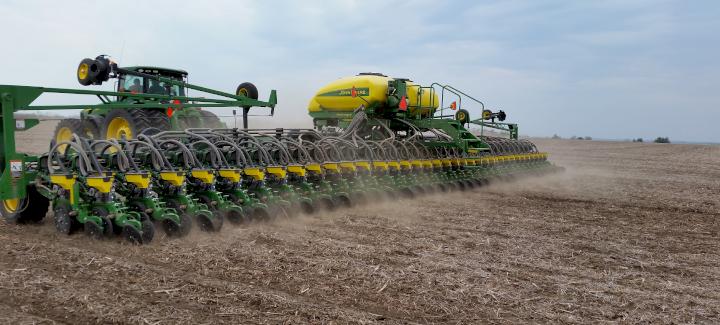While a new season is just around the corner, many areas of the country have already enjoyed spring-like weather this winter. Warm, dry conditions persisted throughout much of February, which could greatly impact this year’s planting and growing seasons.
“Adverse winter conditions could spur herbicide carryover issues and affect insect mortality, especially with the rootworm population this year,” notes Tony Lenz, Stine® technical agronomist.
To see how the warm weather has been impacting soil conditions, Tony and his colleagues did something you don’t typically do in February — soil sampling in our Product Development Plots (PDPs). In southern Minnesota, they measured soil temps at 41 degrees Fahrenheit in one field. In northern Missouri, soil temps were in the upper 50s.
“We saw a lot of 20–30-degree soils over the past two winters and 40–50-degree soils in February across the Midwest,” says Lenz. “Unfortunately, this means there hasn’t been enough killing freezes to eradicate insects such as corn rootworm. There’s also the potential for herbicide carryover as the dry conditions may have made it more difficult to break down last year’s applications, especially late post applications during the growing season.”
Corn Rootworm Concerns
Corn rootworm has been a growing concern across all of Stine’s territories, but especially in the Midwest, where growers are seeing more new variants of western and northern corn rootworm populations.
We’re seeing variants of western corn rootworm pop up after consistent corn-soybean rotations versus corn-on-corn rotations. These variants typically have a one-year life cycle, except for the females that can lay their eggs outside of cornfields in adjacent soybean fields. When corn is planted the next year, the larvae hatch in the fields and cause root injury to the plants. Because of this, we’re even seeing damage to first-year corn. These variants have been observed in areas of Illinois, Iowa, Indiana, Michigan and Ohio.
Northern corn rootworm variants have extended diapause — or a lengthened growth cycle. Eggs can remain dormant in the soil for two winters and wait to hatch until corn is planted again. Like western corn rootworm, they are finding ways to survive the corn-soy rotation, but they have stronger overwintering survival rates and can adapt to longer rotations compared to western corn rootworm. These variants have been found in Minnesota, Nebraska, South Dakota and Wisconsin.
“It’s concerning that the northern corn rootworm variants can survive for two winter seasons, so they’re waiting for that next corn rotation to come back and feed on the crop,” says Lenz. “Also, the damage they are doing underground to the root system is very troubling.”
While people usually scout for rootworm beetles feeding on silks of mature corn plants, growers need to focus on looking underground this year. Western and northern corn rootworm begin feeding on roots as soon as they hatch into larvae.
“We’re seeing a lot of feeding on roots, which leads to hardening off,” says Lenz. “This causes stunted roots and becomes an even bigger problem when you get another drought cycle.”
University research demonstrates that, even at moderate levels, corn rootworm larvae feeding can cause yield losses between 15% to 45%. Fortunately, Stine can help. Tony and our agronomy team recommend leaning on genetics and traits, like Stine DuracadeViptera™, to help combat corn rootworm and other insects, as well as in-furrow insecticides or a combination of both. Stine agronomists are also testing new traits in their PDPs that protect against rootworm and other insects for growers’ consideration in the future.
“If growers are interested in viewing any of our PDP or other plot locations throughout the season, they can connect with their local sales reps to view some of these products in the field,” says Lenz.
Herbicide Carryover
The National Integrated Drought Information System indicates that root zone soil moisture in many parts of the South and Midwest is drier than normal. Dry conditions, combined with other factors such as soil pH, organic matter makeup, temps and timing of applications, can impact the half-life of herbicides.
“The half-life of a herbicide is what it takes for that herbicide to break down to 50%, where it’s not going to be as much of a problem for next year,” says Lenz.
According to the University of Nebraska-Lincoln Extension, chemical processes and microbes are needed to break down herbicides, and these processes require moisture. A lack of moisture can stop the breakdown clock.
“What growers must consider is how the herbicide they applied last summer could affect this year’s crop, especially in a corn-soybean rotation year,” says Lenz.
For example, growers who sprayed Atrazine, Group 27 HPPD or Clopyralid-based herbicides on corn last summer or Fomesafen herbicides like Flexstar in soybeans should be aware of potential herbicide carryover issues the next growing season.
Regardless of the crop, if growers note areas where emergence or stunted plants are an issue, they need to determine what lies beneath.
“If you see an issue, it’s important that you take a sample of the soil and/or plant tissue and send it to the lab right away,” says Lenz. “You want to try and rule out what the issue isn’t and get to the root of the problem instead of guessing.”
No matter your concern heading into the 2024 planting and growing seasons, know that Stine sales reps and our agronomy team are available to help navigate any questions or issues.
![YIELD[+]](/images/site/global/logos/yield-plus.png)



